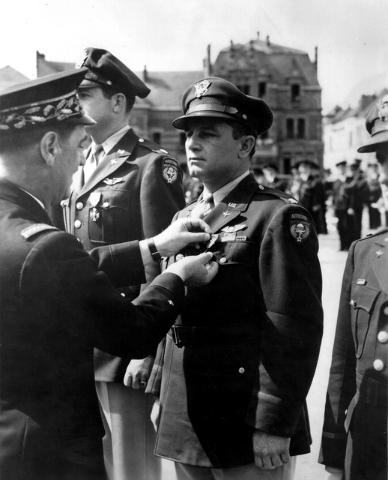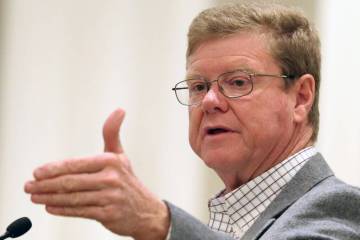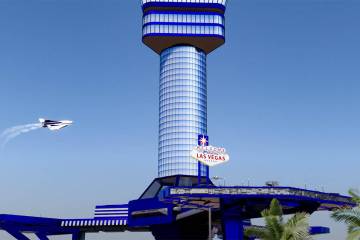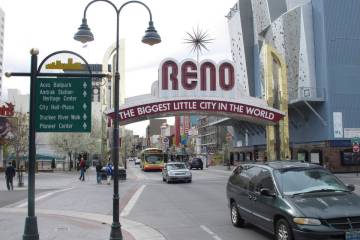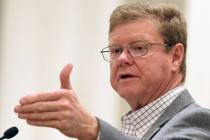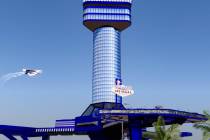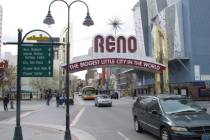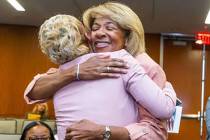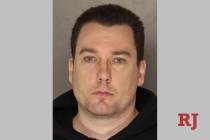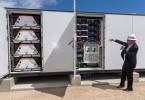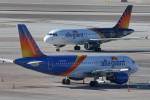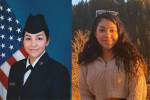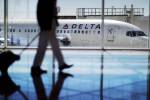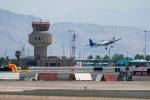Late Sen. Howard Cannon had critical paratrooper role on D-Day
Among the accomplishments of Nevada’s late-Sen. Howard Cannon, from his 33-year political career to his Air Force Reserve service as a major general, his biggest achievement arguably was his role in delivering paratroopers in the lead plane during the June 6, 1944, D-Day invasion of Normandy, France.
With mental toughness and steady hands, then-Maj. Cannon, co-pilot of the C-47 Skytrain “Stoy Hora,” and pilot Col. Frank Krebs, commander of the 440th Troop Carrier Group, spearheaded the assault to free France from the grip of Nazi Germany’s forces.
Had their plane and others in the 45-ship formation not made it to the drop zone near St. Mere Eglise, the soldiers of the 506th Parachute Infantry Regiment might never have been able to provide the cover and distraction for the massive troop landings on the Normandy coast that marked a turning point in World War II.
For that, the grand opening of the extension at the D-Day Paratroopers Historical Center featuring the restored C-47 “Stoy Hora,” the pilot’s log book and other artifacts will be held June 12 in Normandy’s Saint-Come-du-Mont. A flight simulator with special effects will treat visitors to a simulated 7-minute flight inside the aircraft.
Cannon’s daughter, Nancy Downey of Genoa, and Krebs’ daughter, Christine Goyer, will cut the ribbon with Ethan Wolverton, great-grandson of Lt. Col. Robert Wolverton, commander of the 3rd Battalion’s stick of paratroopers, who was killed by Germany machine-gun fire while he dangled in his harness after his parachute caught on a tree.
“In our region, we feel that the pilots and crews have not been significantly recognized for their action on D-Day, and we are attempting to not forget them in our museum extension,” event coordinator Michel de Trez wrote in Downey’s invitation. “It is also our way to honor those who fought and died on the sector where we are located.”
In a telephone interview from Minden last week, Downey said she is looking forward to seeing the C-47 her father flew 71 years ago.
“I think it’s a great honor to be a pilot of something that’s living history, to be a memorial to people like my dad who risked their lives and lost lives to help, not only France, but the world be a safer place,” she said, reflecting on her famous father, who died in 2002 at age 90.
“He was very humble and unassuming. He’s been a tremendous inspiration to me my whole life,” she said.
Clark County, too, has assembled some of Cannon’s photographs and memorabilia for its Cannon Aviation Museum.
“Had we not had the paratroopers, it was highly likely the invasion would not have been successful,” said Mark Hall-Patton, administrator of the Clark County Museum on Boulder Highway in Henderson.
“And to have somebody who later was the local DA and Nevada senator who was co-pilot of the lead plane is huge,” he said.
“He was the one who, among other things, deregulated the airlines and played a key role in passage of the Civil Rights Act. He was a Democrat who was able to bring the Republicans in and get that passed for (President Lyndon B.) Johnson,” Hall-Patton said.
After his death in 2002, a Review-Journal editorial recognized his political savvy. “The senator would never tell what deal President Lyndon Johnson offered him for his role in ending the Southern filibuster which would otherwise have prevented the Civil Rights Act from coming to a vote in 1964.”
Cannon served 24 years as one of Nevada’s U.S. senators, from 1959 to 1983. As a member of the Armed Services and Commerce, Science and Transportation committees and chairman of the Tactical Air Power, Military Construction and Stockpiles subcommittees, he helped secure funding and upgrades for Nellis Air Force Base.
Born in St. George, Utah, in 1912, he became intrigued by the budding aviation industry while attending Dixie Junior College in the 1930s.
“I admit I was more than just a little impressed by the glamour of flying in those days,” he said in an interview for the December 1971 edition of Air Line Pilot magazine. “Lindbergh had recently made his epic ocean-crossing flight, and that added to the pilot mystique that dominated that era.”
As a second lieutenant in the Utah National Guard, he was called to active duty in 1941 and promoted to first lieutenant in charge of a combat engineers unit. He was assigned to the 40th Division in San Luis Obispo, Calif., when Japanese warplanes attacked Pearl Harbor on Dec. 7, 1941. Responding to the need for experienced pilots, he joined the Army Air Corps and graduated from light aircraft and glider school in New Mexico as a captain.
In his biography that Downey helped him write, Cannon described the historic D-Day flight. “Anti-aircraft fire at us as we passed the Channel Islands but we were too low and out of range from them. … As we approached the target, we let down through the stuff and broke out at 700 feet over the green fields of France.”
He saw one of the U.S. planes explode as his C-47 powered toward the drop zone. “Many positions firing tracers,” he wrote. “Many of them had me flinching. Over target — green light — there go the troops. Time 0140 (1:40 a.m.) 6 June 1944.”
His awards and decorations included a Purple Heart, a Distinguished Flying Cross, a presidential citation, and the French Croix de Guerre.
On Sept. 17, 1944, Cannon and Krebs were again flying paratroopers behind enemy lines. This time it was for the allied invasion of the Netherlands for Operation Market Garden. After they had dropped the troops, their plane was hit by anti-aircraft flak, forcing them to bail out.
What followed was a 42-day odyssey during which they evaded their captors with the help of Dutch civilians.
“When I parachuted into Holland, I felt I was nothing — someone small and unimportant — a speck in the universe leaving a disabled plane,” he told Air Line Pilot magazine. “When I left Holland, I sensed I had accomplished far more than our original mission. I had learned from the ‘defeated’ the true meaning of freedom and how we must never give up fighting for it.”
Contact Keith Rogers at krogers@reviewjournal.com or 702-383-0308. Follow @KeithRogers2 on Twitter.









